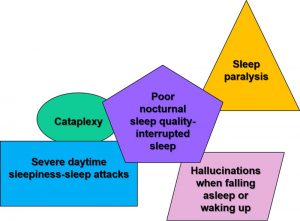

They’ll likely ask if other family members have experienced symptoms like your child, or if they have an official narcolepsy diagnosis. Your doctor will begin by examining your child physically and by taking their medical history.

Knowing that you’re taking care of your child can help you both make it through the testing. Reaching a diagnosis for your child may take time because of the multiple tests that are involved. While a 2018 review shows that 10 to 30 percent of people with narcolepsy type 2 have lower levels of hypocretin, researchers still can’t pinpoint the cause of this type of narcolepsy. The neurons that produce hypocretin are found in the area of the brain called the hypothalamus. It may have an important role in getting good sleep. According to a 2002 study, hypocretin is a chemical messenger called a hypothalamic neuropeptide. Narcolepsy type 1 is linked to the loss of neurons that produce hypocretin. Research suggests that some neurological conditions, injury to the hypothalamus, some syndromes, and certain respiratory tract infections could lead to the development of narcolepsy. But it’s not clear what triggers the immune system in narcolepsy to attack healthy brain cells. In addition to the typical symptoms, a 2021 study reported that teens complained about difficulty focusing, worry about the future, schoolwork, getting easily upset, and dietary challenges.Īre you born with narcolepsy or do you develop it?Ī 2018 review shows that children under 5 to 6 years old rarely have symptoms of the condition.Īlthough researchers aren’t completely sure what causes it, there’s increasing evidence that narcolepsy is an autoimmune disorder. Given the overlap, it’s easy to misinterpret their reactions as behavioral or neurological conditions such as ADHD and to miss the correct diagnosis.Īdolescents and teens often don’t get enough sleep, so diagnosing excessive daytime sleepiness as a symptom of narcolepsy can be especially difficult. (Don’t you know it!) These behaviors are also typical reactions to the extreme sleepiness that characterizes narcolepsy. attention deficit hyperactivity disorder (ADHD), conversion disorder, or oppositional defiant disorderĬhildren tend to become irritable, hyperactive, and spaced out when they get sleepy.cataplexy with unusual facial expressions, tongue sticking out, slurred speech, and restless, fidgety twitches.Research on narcolepsy in children highlights the following symptoms: Speak with your child’s teacher to check if your child has cataplexy episodes in school, trouble focusing, or a tendency to fall asleep in class. In children, episodes of cataplexy can be confused with normal falls or clumsiness. But cataplexy is almost unique to narcolepsy. Many of the major symptoms of narcolepsy can indicate other disorders. frightening hallucinations when falling asleep or waking up.cataplexy or sudden muscle weakness, which often comes at moments of strong emotions such as laughter, anger, or surprise.extreme sleepiness or an irresistible urge to fall asleep, especially with passive activities like reading.Let’s look at typical narcolepsy symptoms and then focus on how these symptoms affect children and adolescents. According to the study, males and females are affected by the condition at similar rates.īecause its symptoms are challenging to recognize and related to so many other diagnoses, narcolepsy may take up to 15 years to diagnose. A 2019 study found that most kids and adolescents with narcolepsy are between 12 and 17 years old. Researchers estimate that narcolepsy affects about 0.025 to 0.05 percent of people.


 0 kommentar(er)
0 kommentar(er)
